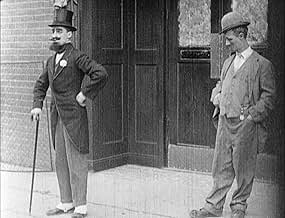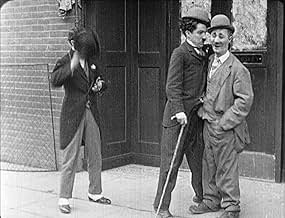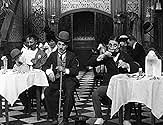Ajouter une intrigue dans votre langueAfter a visit to a pub, Charlie and Ben cause a ruckus at a posh restaurant. Charlie later finds himself in a compromising position at a hotel with the head waiter's wife.After a visit to a pub, Charlie and Ben cause a ruckus at a posh restaurant. Charlie later finds himself in a compromising position at a hotel with the head waiter's wife.After a visit to a pub, Charlie and Ben cause a ruckus at a posh restaurant. Charlie later finds himself in a compromising position at a hotel with the head waiter's wife.
- Réalisation
- Scénario
- Casting principal
Ben Turpin
- Fellow Reveller
- (non crédité)
Charles Allen Dealey
- Restaurant Manager
- (non crédité)
Frank Dolan
- Waiter
- (non crédité)
W. Coleman Elam
- Bit Role
- (non crédité)
Earl Esola
- Bellboy with Cigar Boxes
- (non crédité)
Eddie Fries
- Bit Role
- (non crédité)
Fred Goodwins
- Desk Clerk at Second Hotel
- (non crédité)
Madrona Hicks
- Veiled Woman
- (non crédité)
Bud Jamison
- Headwaiter
- (non crédité)
Daniel P. Kelleher
- Bellboy Carrying Suitcases
- (non crédité)
Edna Purviance
- Headwaiter's Wife
- (non crédité)
Eva Sawyer
- The Count's Companion
- (non crédité)
Lee Willard
- Soup Slurper
- (non crédité)
Fred Windemere
- Cop
- (non crédité)
Avis à la une
This was Charlie Chaplin's second picture at Essanay studios, and his second to co-star Essanay's resident funny man Ben Turpin, who had been with the studio since its first picture in 1907. With the exception of his earliest Keystone appearances, many of which were ensemble pieces, A Night Out is perhaps the closest Charlie came to being part of a double act.
Turpin was neither as versatile or inventive as Chaplin, but he had bags of experience and his movements were spot on. In particular, and importantly for this picture, he could do a great drunken lurch and could pratfall superbly. Here he has almost as much screen time as the tramp himself, and even gets a few bits of comedy business to himself. Chaplin's male co-stars tended to be the butt of much of the physical comedy, and because he falls so well, every time he gets knocked down he draws attention to himself and away from Charlie. Turpin is hilarious here and he really lends something to this picture, but to progress Chaplin couldn't let anyone share his limelight, and it's no surprise that the pair would make just one more picture together.
Like most of the early Essanay shorts, A Night Out doesn't really have much in the way of plot, being simply the tramp (or, in this case, tramps) wandering around causing mayhem in an established environment. Although the result is not entirely satisfying, Chaplin does take time to develop his tramp character with drawn out comedy routines and interaction with the props and people of the setting. He is continually reducing the number of edits and keeping each series of gags to a single shot. For example, in the Keystone pictures and his first Essanay picture (His New Job), when characters get pushed over, more often than not there is a cut showing them flying into the next frame. However, in those early scenes in the restaurant in A Night Out, whenever people fall down it's towards the back of the room, so as not to break the flow at this more relaxed stage of the picture. Chaplin does however put in a few of these two-shot pratfalls towards the end to liven up the frantic finale.
A Night Out marks the debut of Edna Purviance, who would be Chaplin's only leading lady for the next eight years. Chaplin didn't demand his female leads become part of the comedy, he only required them to act well, and Purviance was a superlative actress. She is a relatively minor figure in this one however, although Chaplin does treat her to one of his rare close-ups. A Night Out is also the first time we get to see Leo White's "French character". White was another hilarious supporting player in the Chaplin troupe, who at times would also threaten to upstage Charlie, although his comic persona – a stuck-up, straight-laced twerp – was so different to Chaplin's that he made a perfect counterfoil and antagonist for the tramp. Ben Turpin however was too similar to Chaplin's tramp character, so his days as Charlie's sidekick were numbered. A Night Out is the best opportunity to see him in action.
And now, the all-important statistic –
Number of kicks up the arse: 4 (3 for, 1 against)
Turpin was neither as versatile or inventive as Chaplin, but he had bags of experience and his movements were spot on. In particular, and importantly for this picture, he could do a great drunken lurch and could pratfall superbly. Here he has almost as much screen time as the tramp himself, and even gets a few bits of comedy business to himself. Chaplin's male co-stars tended to be the butt of much of the physical comedy, and because he falls so well, every time he gets knocked down he draws attention to himself and away from Charlie. Turpin is hilarious here and he really lends something to this picture, but to progress Chaplin couldn't let anyone share his limelight, and it's no surprise that the pair would make just one more picture together.
Like most of the early Essanay shorts, A Night Out doesn't really have much in the way of plot, being simply the tramp (or, in this case, tramps) wandering around causing mayhem in an established environment. Although the result is not entirely satisfying, Chaplin does take time to develop his tramp character with drawn out comedy routines and interaction with the props and people of the setting. He is continually reducing the number of edits and keeping each series of gags to a single shot. For example, in the Keystone pictures and his first Essanay picture (His New Job), when characters get pushed over, more often than not there is a cut showing them flying into the next frame. However, in those early scenes in the restaurant in A Night Out, whenever people fall down it's towards the back of the room, so as not to break the flow at this more relaxed stage of the picture. Chaplin does however put in a few of these two-shot pratfalls towards the end to liven up the frantic finale.
A Night Out marks the debut of Edna Purviance, who would be Chaplin's only leading lady for the next eight years. Chaplin didn't demand his female leads become part of the comedy, he only required them to act well, and Purviance was a superlative actress. She is a relatively minor figure in this one however, although Chaplin does treat her to one of his rare close-ups. A Night Out is also the first time we get to see Leo White's "French character". White was another hilarious supporting player in the Chaplin troupe, who at times would also threaten to upstage Charlie, although his comic persona – a stuck-up, straight-laced twerp – was so different to Chaplin's that he made a perfect counterfoil and antagonist for the tramp. Ben Turpin however was too similar to Chaplin's tramp character, so his days as Charlie's sidekick were numbered. A Night Out is the best opportunity to see him in action.
And now, the all-important statistic –
Number of kicks up the arse: 4 (3 for, 1 against)
After this, the second Charles Chaplin two-part Essanay release, it is clear that the comedian lost none of his ability to entertain when he left the Keystone Company. "One Night Out" keeps an audience in an almost perpetual uproar. It is Chaplin at his funniest, and supporting him is a strong company that follows his method as though accustomed to it from long experience. The situations are rather good in themselves and they are used to the very best advantage. - The Moving Picture World, March 6, 1915
Though there are some good moments, mostly later in the feature, overall this short comedy has too much of the same basic material, and it starts to get old rather soon. Charlie Chaplin and Ben Turpin play a couple of drunks who cause a series of difficulties for each other and for those with whom they come in contact. They both do a creditable job (in itself) of performing the material, but it is just too much of the same thing. Drunkenness just is not funny enough to carry even a short feature all by itself, and the use of it as a pretext for the characters to behave in a chronically impolite fashion wears thin relatively quickly.
Things do get a little better in the second half, when the material and the plot become somewhat less one-dimensional. Then too, anything with Chaplin in it will have some good moments - but overall, "A Night Out" is below Chaplin's usual standard. It's probably most memorable for the first of Edna Purviance's many appearances in a Chaplin movie.
Things do get a little better in the second half, when the material and the plot become somewhat less one-dimensional. Then too, anything with Chaplin in it will have some good moments - but overall, "A Night Out" is below Chaplin's usual standard. It's probably most memorable for the first of Edna Purviance's many appearances in a Chaplin movie.
It's difficult to examine the acting done in Chaplin's early comedies, because the term "acting" has to be used to so loosely. Chaplin is at his least impressive for much of the film, stumbling around drunk and causing havoc in a fancy restaurant. Definitely vintage slapstick, but this style has, ahem, gotten a little old.
Anyway, Charlie and a friend have apparently had a big night and are struggling to maintain in a nice restaurant surrounded by well-dressed guests, but soon prove to be nothing but trouble. Before long there is a huge, oafish waiter, who looks more like a bouncer, who has to come in and restore order. It quickly becomes clear that this is a very inexperienced actor. There is one scene where he's smacking Chaplin, and his punches are obviously fake, even in fast motion.
I am not the biggest fan of the violence in Chaplin's films, at least when it's overdone, even though it is generally so over the top that, while it does usually look pretty convincing, it can still get a few laughs. But like it or not, the kicks and punches are usually pretty convincing. Not this guy!
Anyway, the film gives us this example of messy acting, more of a drunken Chaplin, a jealous husband, some seedy motel rooms, and a bit with a dog. What more do we really need?
Anyway, Charlie and a friend have apparently had a big night and are struggling to maintain in a nice restaurant surrounded by well-dressed guests, but soon prove to be nothing but trouble. Before long there is a huge, oafish waiter, who looks more like a bouncer, who has to come in and restore order. It quickly becomes clear that this is a very inexperienced actor. There is one scene where he's smacking Chaplin, and his punches are obviously fake, even in fast motion.
I am not the biggest fan of the violence in Chaplin's films, at least when it's overdone, even though it is generally so over the top that, while it does usually look pretty convincing, it can still get a few laughs. But like it or not, the kicks and punches are usually pretty convincing. Not this guy!
Anyway, the film gives us this example of messy acting, more of a drunken Chaplin, a jealous husband, some seedy motel rooms, and a bit with a dog. What more do we really need?
One of Chaplin's better efforts from his early days at Essanay which isn't really that much of a recommendation, as both Chaplin and his creation were far from the finished article when this was made. With his exaggerated motions and heavy-eyed contemplation of things he can't quite understand due to his inebriated state, Chaplin exquisitely captures the behaviour of one who has had more than one too many. He's partnered for the first time with Edna Purviance here, and they work well together. The story itself is typical of the violence with which Chaplin's work seemed to be obsessed at this time. He had obviously found a formula that worked
Le saviez-vous
- AnecdotesThis was Edna Purviance's first film with Charles Chaplin.
- GaffesThe hotel number for Reveller (Charlie Chaplin) and Fellow Reveller changes. When Fellow Reveller first enters the room the number on the door is clearly visible as 3. When Reveller is followed into the room by Headwaiter the room number changes to 2. It changes back to 3 when Fellow Reveller leaves the room for the final time.
- ConnexionsEdited into The Essanay-Chaplin Revue of 1916 (1916)
Meilleurs choix
Connectez-vous pour évaluer et suivre la liste de favoris afin de recevoir des recommandations personnalisées
Détails
- Date de sortie
- Pays d’origine
- Sites officiels
- Langues
- Aussi connu sous le nom de
- Charlot en bombe
- Lieux de tournage
- Société de production
- Voir plus de crédits d'entreprise sur IMDbPro
- Durée34 minutes
- Couleur
- Mixage
- Rapport de forme
- 1.33 : 1
Contribuer à cette page
Suggérer une modification ou ajouter du contenu manquant

Lacune principale
By what name was Charlot fait la noce (1915) officially released in Canada in English?
Répondre


























